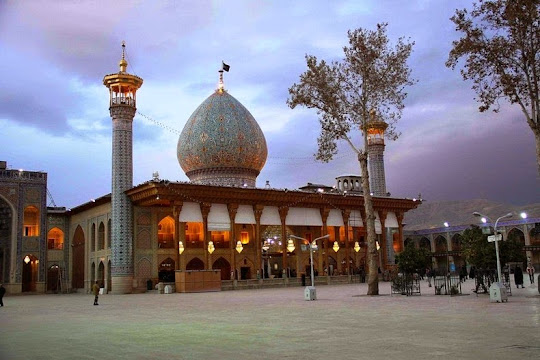
The wide mosque is flanked by two minarets and dominated by a dome is located in the west wing. The high eaves are supported by thick octagonal columns connected by a wall of green marble, carved entirely of wood. The entrance is guarded by a heavy door, plated with gold and enamel with a glass panel at its center. The pilgrims kiss and fondle the door as you enter.
Inside, the enormous dome above the shrine is inlaid with hundreds of thousands of pieces of finely crafted tiles, and the interior walls are covered with myriad pieces of dazzling glass intermixed with multi-colored tiles – green, yellow, red and blue, interspersed with glasses of paler shades sometimes. High and large windows down to the ground are largely made up of mosaics of stained glass which are reflected in the mosaics of mirrors. Embedded in the walls everywhere are verses from the Quran written on silk paper and framed. The green marble floor is covered with thick red Iranian carpets and magnificent crystal chandeliers hang from the ceiling above.

In the center, under the dome, lies the tomb of Syed Mir Ahmad. The marble tombstone, topped with a wide, low lacquer box inlaid structure is surrounded by a finely engraved silver with glass openings showing the inside. Verses from the Quran are written in gold letters on a blue background, and flowers are inlaid or carved into the metal. In another corner lies the tomb of Mir Muhammad that looks the same but much smaller than the tomb of his elder brother.
The brothers’ tombs were built in the 12th century by the chief minister to the monarch Atabeg Abū Sa'id Zangi, who also built the tomb chamber, the dome, as well as a colonnaded porch. The mosque remained this way for roughly 200 years before further work was initiated by Queen Tash Khātūn during the years 1344-1349 AD. She carried out essential repairs, constructed an edifice, a hall of audience, a fine college, and a tomb for herself on the south side. She also presented a unique Qur'an of thirty volumes, written in golden Sols characters with gold decoration, which is now preserved in the Pars Museum.












Source
